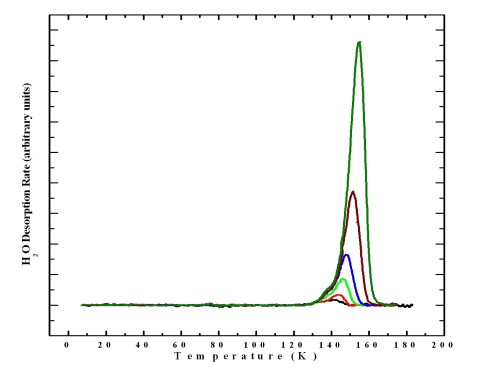The Heriot-Watt Astrochemistry Research Group |
 |
Thermal Desorption of Pure Water Ice in the Interstellar Medium

There is one intense peak at ~140 K, which is associated with desorption of the bulk ice film. The shape of the leading edge does not vary with increasing exposure, although the peak temperature does increase with coverage. This is indicative of a desorption process following zeroth-order kinetics, which is typical for multilayer desorption processes.
The peak position shifts because of the exponential rise in the rate of desorption with increasing temperature. The desorption rate increases indefinitely until all of the layers of ice have desorbed, at which point the TPD signal falls rapidly to zero.
Sometimes a slight shoulder can be seen on the leading edge of the peak. This is because of a phase transition between amorphous and crystalline water ice which occurs at 120 to 140K under these experimental conditions. The relatively long timescale for the phase change means it is likely that, although most of the desorption will be from crystalline ice, some desorption will be from the residual amorphous ice. The TPD peak for the amorphous ice occurs at a lower temperature than the main peak because amorphous ice has a higher vapour pressure than crystalline ice.
This research is included in the following publication:
H. J. Fraser, M. P. Collings, M. R. S. McCoustra and D. A. Williams
Monthly Notices of the Royal Astronomical Society,